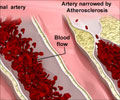Previous research has shown that excess smooth muscle is a root problem in many vascular diseases, as it causes arteries to constrict and blood pressure to rise.

The findings reported in the Cell Press journal Cell Reports on February 27th are important because nearly half of patients with pulmonary hypertension die within three years of diagnosis, in part because treatments do little to limit smooth muscle cell accumulation in places where the cells don't belong.
Author Daniel Greif of Yale University School of Medicine explains what happens to the heart in pulmonary hypertension by way of analogy: "It's like turning on a water spigot with a hose and, at the same time, squeezing the hose. With increased resistance in the system, the pump has to work harder to get water out, and ultimately the pump fails."
To find out where that resistance and muscle comes from, Greif and his colleagues studied what happens in vessels over time as a result of inadequate oxygen levels (known as hypoxia). Hypoxia is a well-established independent cause of pulmonary hypertension in humans, and mice exposed to hypoxia for a period of three weeks develop pulmonary hypertension too.
The researchers marked cells in mice and tracked them over time in response to those low-oxygen conditions. They observed that normal smooth muscle cells migrate and return to an undifferentiated state before becoming smooth muscle again in blood vessels that normally lack muscle.
"The cells de-differentiate and migrate down, then have a burst of proliferation," Greif said. "Eventually, they re-differentiate and become less proliferative.
Advertisement
Indeed, the findings may lead to novel treatments for pulmonary hypertension and other vascular conditions, including atherosclerosis and restenosis, the secondary narrowing of blood vessels that occurs in many patients after doctors treat them for blockages with balloon angioplasty.
Advertisement
"The next step is the identification of pharmacological agents that could be used to attenuate that process [by targeting the smooth muscle directly]," Greif said. "There are many cell types in the lung; if we can work toward therapies that target the culprit cell type, that's a step in the right direction."
Source-Eurekalert

![Pulmonary Arterial Hypertension [PAH] - Symptoms & Signs - Causes - Diagnosis - Treatment Pulmonary Arterial Hypertension [PAH] - Symptoms & Signs - Causes - Diagnosis - Treatment](https://images.medindia.net/patientinfo/120_100/pulmonary-arterial-hypertension-pah.jpg)












